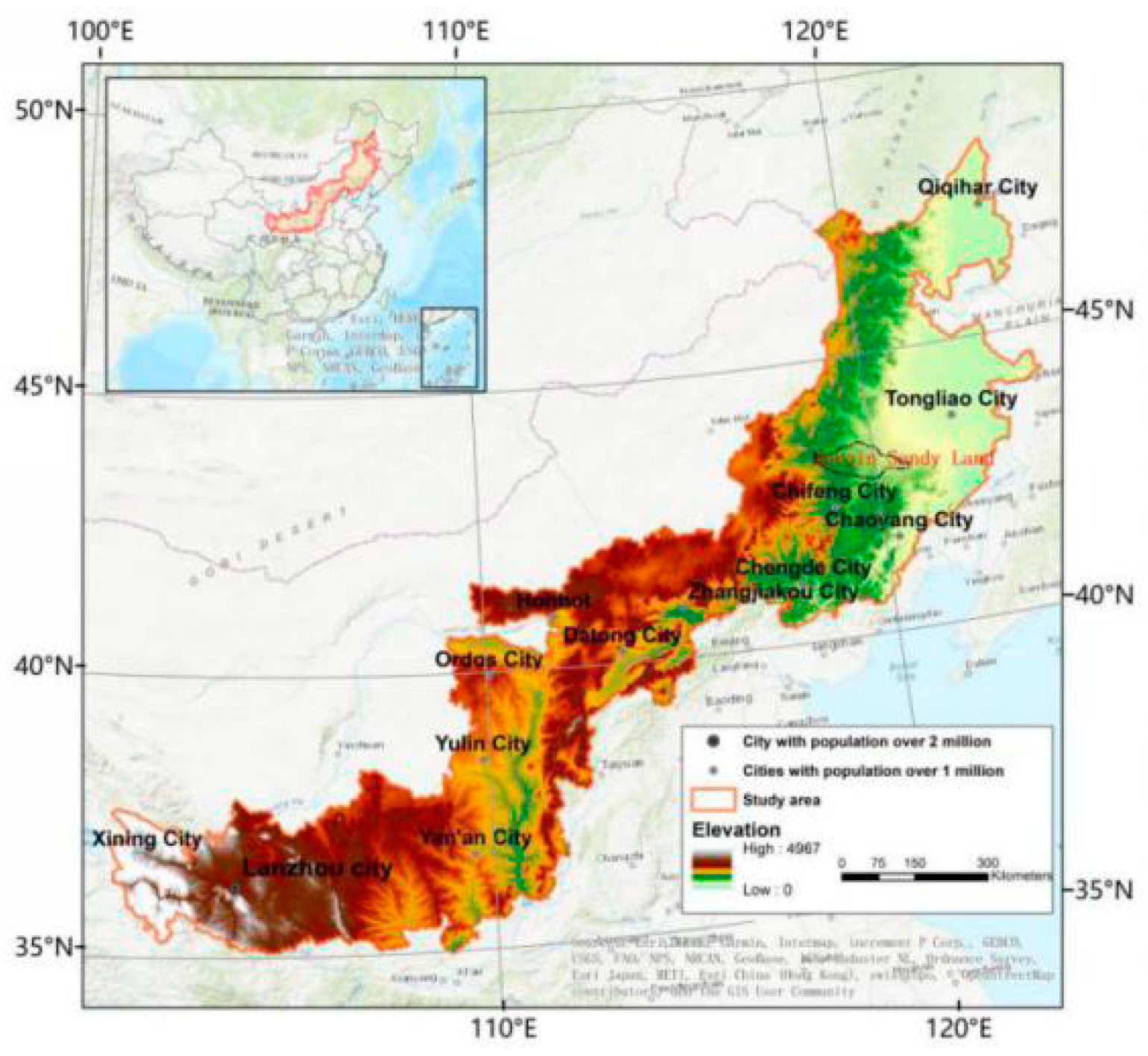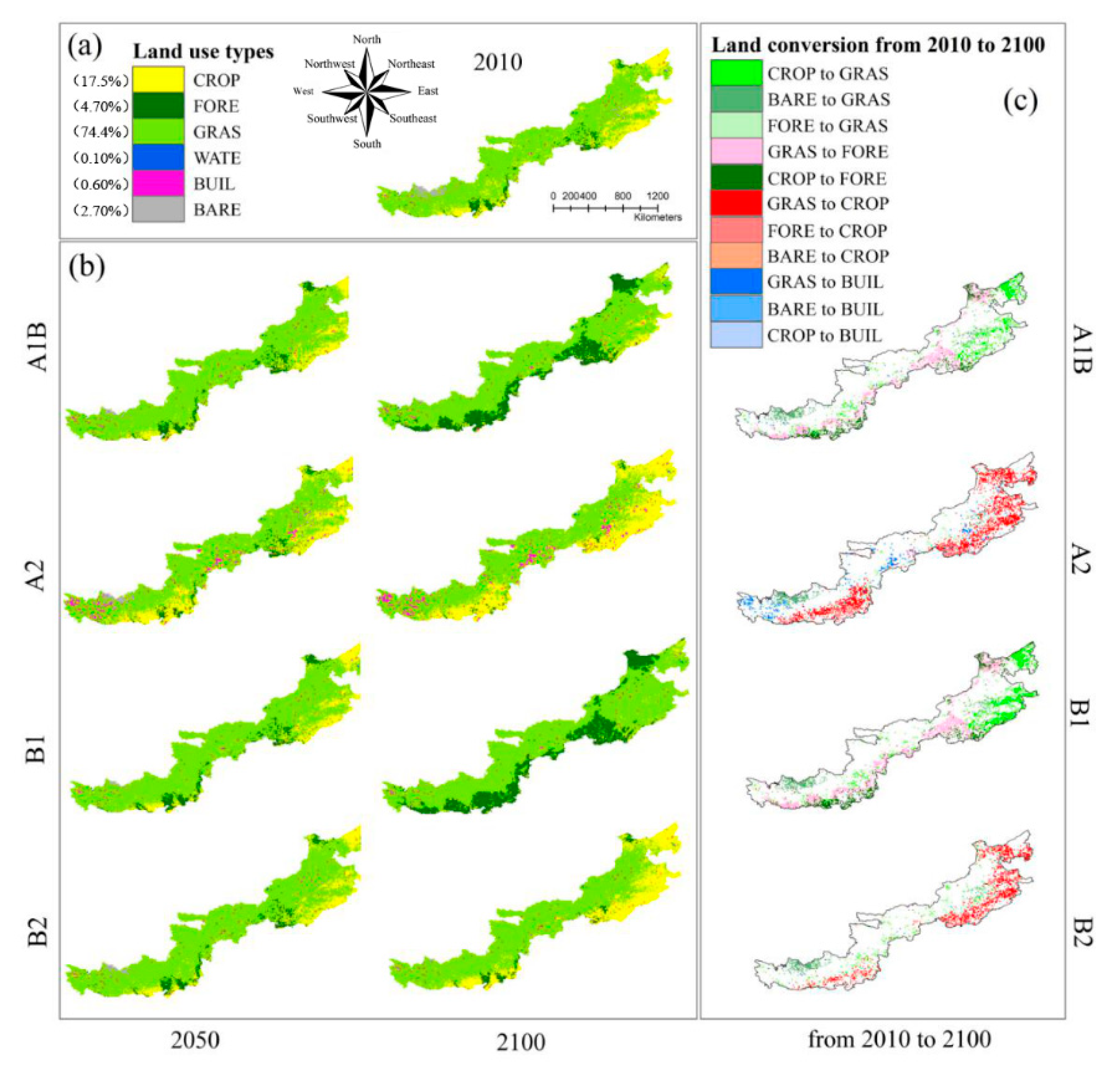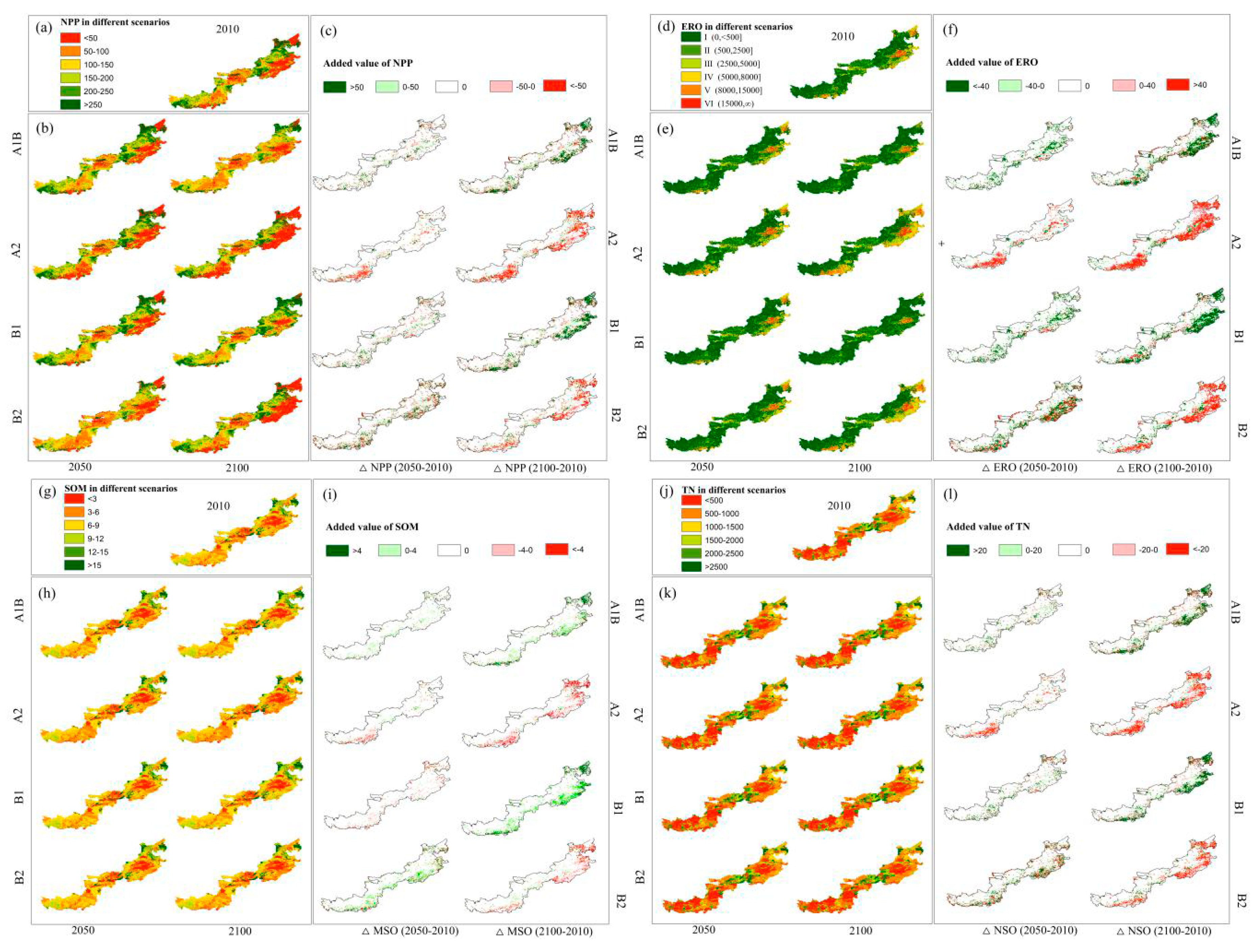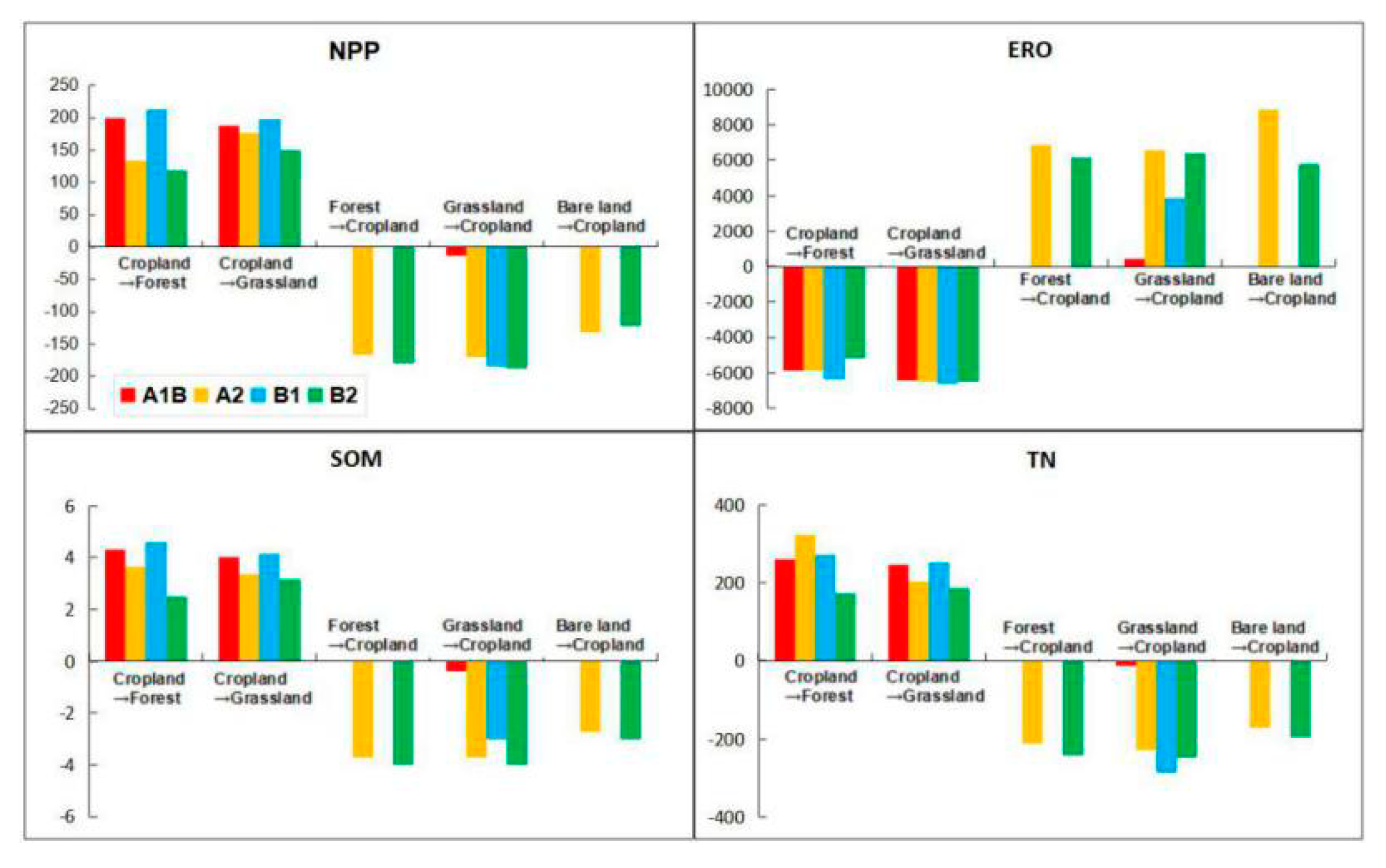Major Consequences of Land-Use Changes for Ecosystems in the Future in the Agro-Pastoral Transitional Zone of Northern China
Abstract
1. Introduction
2. Materials and Methods
2.1. Study Area
2.2. Data Preparation
2.3. Scenarios Development
- A1B: Low population growth; High gross domestic productivity (GDP) growth; Sprawling urban expansion; Rapid technological innovation; Energy sector—Balanced; Active management of resources.
- A2: High population growth; Low GDP growth; Sprawling urban expansion; Slow technological innovation; Energy sector—Fossil fuels; Low resources protection.
- B1: Low population growth; High GDP growth; Compact urban expansion; Rapid technological innovation; Energy sector—Renewable; Protection of biodiversity.
- B2: Medium population growth; Medium GDP growth; Compact urban expansion; Medium technological innovation; Energy sector—Mixed; Protection of biodiversity.
2.4. Land Use Allocation and Ecosystem Consequences
2.4.1. Land Use Allocation Module
2.4.2. Terrestrial Ecosystem Simulator
2.5. Processes of Results Analysis
3. Results
3.1. The Spatiotemporal Patterns of Land Use and Land Cover Change
3.2. The Dynamics of Ecological Functions
3.3. Impacts of Land Use and Land Cover Dynamics on Ecological Functions
3.3.1. Impacts of Land Use and Land Cover Types on Ecological Functions
3.3.2. Impacts of Land Use and Land Cover Conversions on Ecological Functions
3.4. The Trade-Offs between Different Ecosystem Functions in 2010
4. Discussion
4.1. What Are the Spatial Patterns of Land Use and Land Cover under Different Scenarios?
4.2. What Are the Major Consequences of LULC for Ecosystem Functions in the Future?
4.3. What Are the Implications of Mitigation and Adaptation Strategies to Climate Changes?
4.4. Can Trade-Offs between Intended and Unintended Consequences of Land Use Be Quantified to Inform Planning and Decision-Making?
4.5. Limitation and Prospects
5. Conclusions
Author Contributions
Funding
Conflicts of Interest
References
- Turner, B.L.; Meyer, W.B.; Skole, D.L. Global Land-Use/Land-Cover Change: Towards an Integrated Study. Ambio 1994, 23, 91–95. [Google Scholar]
- Parker, D.C.; Manson, S.M.; Janssen, M.A.; Hoffmann, M.J.; Deadman, P. Multi-Agent Systems for the Simulation of Land-Use and Land-Cover Change: A Review. Ann. Assoc. Am. Geogr. 2003, 93, 314–337. [Google Scholar] [CrossRef]
- Wu, J.; He, C.; Zhang, Q.; Yu, D.; Huang, Q. Integrative modeling and strategic planning for regional sustainability under climate change. Adv. Earth Sci. 2014, 29, 1315–1324. [Google Scholar]
- Touseef, M.; Chen, L.; Masud, T.; Khan, A.; Yang, K.; Shahzad, A.; Ijaz, M.W.; Wang, Y. Assessment of the Future Climate Change Projections on Streamflow Hydrology and Water Availability over Upper Xijiang River Basin, China. Appl. Sci. 2020, 10, 3671. [Google Scholar] [CrossRef]
- Foley, J.A.; Ramankutty, N.; Brauman, K.A.; Cassidy, E.S.; Gerber, J.S.; Johnston, M.; Mueller, N.D.; O’Connell, C.; Ray, D.; West, P.C.; et al. Solutions for a cultivated planet. Nature 2011, 478, 337–342. [Google Scholar] [CrossRef]
- Mace, G.M.; Norris, K.; Fitter, A.H. Biodiversity and ecosystem services: A multilayered relationship. Trends Ecol. Evol. 2012, 27, 19–26. [Google Scholar] [CrossRef]
- Verburg, P.H.; Dearing, J.A.; Dyke, J.G.; Van Der Leeuw, S.; Seitzinger, S.; Steffen, W.; Syvitski, J. Methods and approaches to modelling the Anthropocene. Glob. Environ. Chang. 2016, 39, 328–340. [Google Scholar] [CrossRef]
- Horion, S.; Ivits, E.; De Keersmaecker, W.; Tagesson, T.; Vogt, J.; Fensholt, R. Mapping European ecosystem change types in response to land-use change, extreme climate events, and land degradation. Land Degrad. Dev. 2019, 30, 951–963. [Google Scholar] [CrossRef]
- Zhao, Y.; Liu, Z.; Wu, J. Grassland ecosystem services: A systematic review of research advances and future directions. Landsc. Ecol. 2020, 35, 793–814. [Google Scholar] [CrossRef]
- Pickett, S.T.A.; Cadenasso, M.L. Landscape Ecology: Spatial Heterogeneity in Ecological Systems. Science 1995, 269, 331–334. [Google Scholar] [CrossRef]
- Alberti, M. The Effects of Urban Patterns on Ecosystem Function. Int. Reg. Sci. Rev. 2005, 28, 168–192. [Google Scholar] [CrossRef]
- Cao, Q.; Wu, J.; Yu, D.; Wang, W. The biophysical effects of the vegetation restoration program on regional climate metrics in the Loess Plateau, China. Agric. For. Meteorol. 2019, 268, 169–180. [Google Scholar] [CrossRef]
- Schlesinger, W.H.; Andrews, J.A. Soil respiration and the global carbon cycle. Biogeochemistry 2000, 48, 7–20. [Google Scholar] [CrossRef]
- Houghton, R.A. Revised estimates of the annual net flux of carbon to the atmosphere from changes in land use and land management 1850–2000. Tellus Ser. B Chem. Phys. Meteorol. 2003, 55, 378–390. [Google Scholar]
- Xu, X.; Jiang, H.; Tian, X.; Guan, M.; Wang, L. Response of the Plant and Soil Features to Degradation Grades in Semi-arid Grassland of the Inner Mongolia, China. IOP Conf. Ser. Mater. Sci. Eng. 2019, 484, 012039. [Google Scholar] [CrossRef]
- Zhang, Q.; Kong, D.; Singh, V.P.; Shi, P. Response of vegetation to different time-scales drought across China: Spatiotemporal patterns, causes and implications. Glob. Planet Chang. 2017, 152, 1–11. [Google Scholar] [CrossRef]
- McDonagh, J.; Birch-Thomsen, T.; Magid, J. Soil organic matter decline and compositional change associated with cereal cropping in southern Tanzania. Land Degrad. Dev. 2001, 12, 13–26. [Google Scholar] [CrossRef]
- Fazhu, Z.; Jiao, S.; Chengjie, R.; Di, K.; Jian, D.; Han, X.; Gaihe, Y.; Yongzhong, F.; Guangxin, R. Land use change influences soil C, N and P stoichiometry under ‘Grain-to-Green Program’ in China. Sci. Rep. 2015, 5, srep10195. [Google Scholar] [CrossRef]
- Wang, J.; Peng, J.; Zhao, M.; Yanxu, L.; Chen, Y. Significant trade-off for the impact of Grain-for-Green Programme on ecosystem services in North-western Yunnan, China. Sci. Total Environ. 2017, 574, 57–64. [Google Scholar] [CrossRef]
- McGarigal, K.; Marks, B.J. FRAGSTATS: Spatial Pattern Analysis Program for Quantifying Landscape Structure; USDA Forest Service: Portland, OR, USA, 1995; p. 351.
- Gustafson, E.J. Minireview: Quantifying Landscape Spatial Pattern: What Is the State of the Art? Ecosystems 1998, 1, 143–156. [Google Scholar] [CrossRef]
- Luck, M.; Wu, J. A gradient analysis of urban landscape pattern: A case study from the Phoenix metropolitan region, Arizona, USA. Landsc. Ecol. 2002, 17, 327–339. [Google Scholar] [CrossRef]
- Wu, J. Effects of changing scale on landscape pattern analysis: Scaling relations. Landsc. Ecol. 2004, 19, 125–138. [Google Scholar] [CrossRef]
- Lovett, G.M.; Jones, C.G.; Turner, M.; Weathers, K.C. Ecosystem Function in Heterogeneous Landscapes. Ecosyst. Funct. Heterog. Landsc. 2007, 1–4. [Google Scholar] [CrossRef]
- Hao, R.; Yu, D.; Liu, Y.; Liu, Y.; Qiao, J.; Wang, X.; Du, J. Impacts of changes in climate and landscape pattern on ecosystem services. Sci. Total Environ. 2017, 579, 718–728. [Google Scholar] [CrossRef] [PubMed]
- Scarnecchia, D.L.; Jorgensen, S.E. Fundamentals of Ecological Modelling. J. Range Manag. 1995, 48, 566. [Google Scholar] [CrossRef]
- Gao, Q.; Yu, M.; Yang, X.; Wu, J. Scaling simulation models for spatially heterogeneous ecosystems with diffusive transportation. Landsc. Ecol. 2001, 16, 289–300. [Google Scholar] [CrossRef]
- DeAngelis, D.L.; Yurek, S. Spatially Explicit Modeling in Ecology: A Review. Ecosystems 2016, 20, 284–300. [Google Scholar] [CrossRef]
- Grimm, V.; Ayllón, D.; Railsback, S.F. Next-Generation Individual-Based Models Integrate Biodiversity and Ecosystems: Yes We Can, and Yes We Must. Ecosystems 2016, 20, 229–236. [Google Scholar] [CrossRef]
- Peters, D.P.; Okin, G.S. A Toolkit for Ecosystem Ecologists in the Time of Big Science. Ecosystems 2016, 20, 259–266. [Google Scholar] [CrossRef]
- Moloney, K.; Levin, S.A. The Effects of Disturbance Architecture on Landscape-Level Population Dynamics. Ecology 1996, 77, 375–394. [Google Scholar] [CrossRef]
- Rastetter, E.B. Modeling for Understanding v. Modeling for Numbers. Ecosystems 2016, 20, 215–221. [Google Scholar] [CrossRef]
- Turner, M.; Carpenter, S.R. Ecosystem Modeling for the 21st Century. Ecosystems 2016, 20, 211–214. [Google Scholar] [CrossRef]
- Potter, C.; Randerson, J.T.; Field, C.B.; Matson, P.A.; Vitousek, P.M.; Mooney, H.A.; Klooster, S.A. Terrestrial ecosystem production: A process model based on global satellite and surface data. Glob. Biogeochem. Cycles 1993, 7, 811–841. [Google Scholar] [CrossRef]
- Rafique, R.; Xia, J.; Hararuk, O.; Leng, G.; Asrar, G.; Luo, Y.; Rafique, R. Comparing the Performance of Three Land Models in Global C Cycle Simulations: A Detailed Structural Analysis. Land Degrad. Dev. 2016, 28, 524–533. [Google Scholar] [CrossRef]
- Martine, J.V.D.P.; Jantiene, E.M.B.; David, A.R. Biophysical landscape interactions: Bridging disciplines and scale with connectivity. Land Degrad. Dev. 2018, 29, 1167–1175. [Google Scholar]
- Fryrear, D.W.; Saleh, A.; Bilbro, J.B. A single event wind erosion model. Trans. ASAE 1998, 41, 1369. [Google Scholar] [CrossRef]
- Borrelli, P.; Lugato, E.; Montanarella, L.; Panagos, P. A New Assessment of Soil Loss Due to Wind Erosion in European Agricultural Soils Using a Quantitative Spatially Distributed Modelling Approach. Land Degrad. Dev. 2016, 28, 335–344. [Google Scholar] [CrossRef]
- Parton, W.J.; Schimel, D.; Cole, C.V.; Ojima, D.S. Analysis of Factors Controlling Soil Organic Matter Levels in Great Plains Grasslands. Soil Sci. Soc. Am. J. 1987, 51, 1173–1179. [Google Scholar] [CrossRef]
- Parton, W.J.; Stewart, J.W.B.; Cole, C.V. Dynamics of C, N, P and S in grassland soils: A model. Biogeochemistry 1988, 5, 109–131. [Google Scholar] [CrossRef]
- Parton, W.J.; Neff, J.; Vitousek, P.M. Modelling phosphorus, carbon and nitrogen dynamics in terrestrial ecosystems. Org. Phosphorus Environ. 2005. [Google Scholar] [CrossRef]
- Running, S.W.; Coughlan, J.C. A general model of forest ecosystem processes for regional applications I. Hydrologic balance, canopy gas exchange and primary production processes. Ecol. Model. 1988, 42, 125–154. [Google Scholar] [CrossRef]
- Running, S.W.; Hunt, E.R. Generalization of a Forest Ecosystem Process Model for Other Biomes, BIOME-BGC, and an Application for Global-Scale Models. Scaling Physiol. Proc. 1993, 141–158. [Google Scholar] [CrossRef]
- Churkina, G.; Running, S.W. Contrasting Climatic Controls on the Estimated Productivity of Global Terrestrial Biomes. Ecosystems 1998, 1, 206–215. [Google Scholar] [CrossRef]
- Sanchez-Ruiz, S.; Chiesi, M.; Fibbi, L.; Carrara, A.; Maselli, F.; Gilabert, M. Optimized Application of Biome-BGC for Modeling the Daily GPP of Natural Vegetation Over Peninsular Spain. J. Geophys. Res. Biogeosci. 2018, 123, 531–546. [Google Scholar] [CrossRef]
- Jiang, H.; Xu, X.; Guan, M.; Wang, L.; Huang, Y.; Jiang, Y. Determining the contributions of climate change and human activities to vegetation dynamics in agro-pastural transitional zone of northern China from 2000 to 2015. Sci. Total Environ. 2020, 718, 134871. [Google Scholar] [CrossRef]
- Nakicenovic, N.; Alcamo, J.; Davis, G.; Vries, B.D. Special Report on Emissions Scenarios: A Special Report of the Working Group III of the Intergovernmental Panel on Climate Change; Cambridge University Press: Cambridge, UK, 2000. [Google Scholar]
- Sleeter, B.M.; Sohl, T.L.; Bouchard, M.A.; Reker, R.R.; Soulard, C.E.; Acevedo, W.; Griffith, G.E.; Sleeter, R.R.; Auch, R.F.; Sayler, K.L.; et al. Scenarios of land use and land cover change in the conterminous United States: Utilizing the special report on emission scenarios at ecoregional scales. Glob. Environ. Chang. 2012, 22, 896–914. [Google Scholar] [CrossRef]
- Li, X.; Yu, L.; Sohl, T.; Clinton, N.; Li, W.; Zhu, Z.; Liu, X.; Gong, P. A cellular automata downscaling based 1 km global land use datasets (2010–2100). Sci. Bull. 2016, 61, 1651–1661. [Google Scholar] [CrossRef]
- Luoto, M.; Virkkala, R.; Heikkinen, R.K. The role of land cover in bioclimatic models depends on spatial resolution. Glob. Ecol. Biogeogr. 2007, 16, 34–42. [Google Scholar] [CrossRef]
- Di Febbraro, M.; Menchetti, M.; Russo, D.; Ancillotto, L.; Aloise, G.; Roscioni, F.; Preatoni, D.; Loy, A.; Martinoli, A.; Bertolino, S.; et al. Integrating climate and land-use change scenarios in modelling the future spread of invasive squirrels in Italy. Divers. Distrib. 2019, 25, 644–659. [Google Scholar] [CrossRef]
- Strayer, D.L.; Beighley, R.E.; Thompson, L.C.; Brooks, S.; Nilsson, C.; Pinay, G.; Naiman, R.J. Effects of land cover on stream ecosystems: Roles of empirical models and scaling issues. Ecosystems 2003, 6, 407–423. [Google Scholar] [CrossRef]
- Milano, M.; Reynard, E.; Köplin, N.; Weingartner, R. Climatic and anthropogenic changes in Western Switzerland: Impacts on water stress. Sci. Total Environ. 2015, 536, 12–24. [Google Scholar] [CrossRef] [PubMed]
- Yu, J.; Liu, J.; Wang, J.; Liu, S.; Qi, X.; Wang, Y.; Wang, G. Organic Carbon Variation Law of Black Soil During Different Tillage Period. J. Soil Water Conserv. 2004, 18, 27–30. [Google Scholar]
- Pielke, R.A.; Marland, G.; Betts, R.A.; Chase, T.N.; Eastman, J.L.; Niles, J.O.; Niyogi, D.D.S.; Running, S.W. The influence of land-use change and landscape dynamics on the climate system: Relevance to climate-change policy beyond the radiative effect of greenhouse gases. Philos. Trans. R. Soc. A Math. Phys. Eng. Sci. 2002, 360, 1705–1719. [Google Scholar] [CrossRef] [PubMed]
- Gao, Q.; Yu, M.; Liu, Y.; Xu, H.; Xu, X. Modeling interplay between regional net ecosystem carbon balance and soil erosion for a crop-pasture region. J. Geophys. Res. Space Phys. 2007, 112, 112. [Google Scholar] [CrossRef]
- Heistermann, M.; Müller, C.; Ronneberger, K. Land in sight?Achievements, deficits and potentials of continental to global scale land-use modeling. Agric. Ecosyst. Environ. 2006, 114, 141–158. [Google Scholar] [CrossRef]
- Sohl, T.L.; Sayler, K.L.; Bouchard, M.A.; Reker, R.R.; Friesz, A.M.; Bennett, S.L.; Sleeter, B.M.; Sleeter, R.R.; Wilson, T.S.; Soulard, C.; et al. Spatially explicit modeling of 1992–2100 land cover and forest stand age for the conterminous United States. Ecol. Appl. 2014, 24, 1015–1036. [Google Scholar] [CrossRef]
- Wilson, T.S.; Sleeter, B.M.; Davis, A.W. Potential future land use threats to California’s protected areas. Reg. Environ. Chang. 2014, 15, 1051–1064. [Google Scholar] [CrossRef]
- Liu, X.; Liang, X.; Li, X.; Xu, X.; Ou, J.; Chen, Y.; Li, S.; Wang, S.; Pei, F. A future land use simulation model (FLUS) for simulating multiple land use scenarios by coupling human and natural effects. Landsc. Urban Plan. 2017, 168, 94–116. [Google Scholar] [CrossRef]
- Wang, J.; Xu, X.; Liu, P. Land use and land carrying capacity in ecotone between agriculture and animal husbandry in northern China. Resour. Sci. 1999, 21, 19–24. [Google Scholar]
- Shi, P. Pattern and Optimization Simulation of Land Use in Pastoral Transitional Zone in Northern China; Science Press: Beijing, China, 2009. [Google Scholar]
- Jiang, H.; Xu, X.; Guan, M.; Wang, L.; Huang, Y.; Liu, Y. Simulation of Spatiotemporal Land Use Changes for Integrated Model of Socioeconomic and Ecological Processes in China. Sustainability 2019, 11, 3627. [Google Scholar] [CrossRef]
- Huang, D.; Wang, K.; Wu, W. Problems and strategies for sustainable development of farming and animal husbandry in the Agro-Pastoral Transition Zone in Northern China (APTZNC). Int. J. Sustain. Dev. World Ecol. 2007, 14, 391–399. [Google Scholar] [CrossRef]
- Gaffin, S.R.; Rosenzweig, C.; Xing, X.; Yetman, G. Downscaling and geo-spatial gridding of socio-economic projections from the IPCC Special Report on Emissions Scenarios (SRES). Glob. Environ. Chang. 2004, 14, 105–123. [Google Scholar] [CrossRef]
- Rounsevell, M.; Reginster, I.; Araújo, M.B.; Carter, T.; Dendoncker, N.; Ewert, F.; House, J.I.; Kankaanpää, S.; Leemans, R.; Metzger, M.; et al. A coherent set of future land use change scenarios for Europe. Agric. Ecosyst. Environ. 2006, 114, 57–68. [Google Scholar] [CrossRef]
- Xu, X.; Gao, Q.; Liu, Y.-H.; Wang, J.-A.; Zhang, Y. Coupling a land use model and an ecosystem model for a crop-pasture zone. Ecol. Model. 2009, 220, 2503–2511. [Google Scholar] [CrossRef]
- DeFries, R.S.; Asner, G.P.; Houghton, R.A. Trade-offs in land-use decisions: Towards a framework for assessing multiple ecosystem responses to land-use change. In Ecosystems and Land Use Change; Blackwell Publishing Ltd.: Oxford, UK, 2004; Volume 153, pp. 1–9. [Google Scholar]
- Veldkamp, A.; Verburg, P. Modelling land use change and environmental impact. J. Environ. Manag. 2004, 72, 1–3. [Google Scholar] [CrossRef]
- Verburg, P.H.; De Koning, G.; Kok, K.; Veldkamp, A.; Bouma, J. A spatial explicit allocation procedure for modelling the pattern of land use change based upon actual land use. Ecol. Model. 1999, 116, 45–61. [Google Scholar] [CrossRef]
- Verburg, P.H. Simulating feedbacks in land use and land cover change models. Landsc. Ecol. 2006, 21, 1171–1183. [Google Scholar] [CrossRef]
- Verburg, P.H.; Overmars, K.P. Combining top-down and bottom-up dynamics in land use modeling: Exploring the future of abandoned farmlands in Europe with the Dyna-CLUE model. Landsc. Ecol. 2009, 24, 1167–1181. [Google Scholar] [CrossRef]
- Rounsevell, M.D.A.; Reay, D.S. Land use and climate change in the UK. Land Policy 2009, 26, S160–S169. [Google Scholar] [CrossRef]
- Solecki, W.; Oliveri, C. Downscaling climate change scenarios in an urban land use change model. J. Environ. Manag. 2004, 72, 105–115. [Google Scholar] [CrossRef]
- Hansen, H.S. Modelling the future coastal zone urban development as implied by the IPCC SRES and assessing the impact from sea level rise. Landsc. Urban Plan. 2010, 98, 141–149. [Google Scholar] [CrossRef]
- Han, H.; Hwang, Y.; Ha, S.R.; Kim, B.S. Modeling Future Land Use Scenarios in South Korea: Applying the IPCC Special Report on Emissions Scenarios and the SLEUTH Model on a Local Scale. Environ. Manag. 2015, 55, 1064–1079. [Google Scholar] [CrossRef] [PubMed]
- Li, P.; Liu, L.; Wang, J.; Wang, Z.; Wang, X.; Bai, Y.; Chen, S. Wind erosion enhanced by land use changes significantly reduces ecosystem carbon storage and carbon sequestration potentials in semiarid grasslands. Land Degrad. Dev. 2018, 29, 3469–3478. [Google Scholar] [CrossRef]
- Zhang, S.; Fan, W.; Li, Y.; Yi, Y. The influence of changes in land use and landscape patterns on soil erosion in a watershed. Sci. Total Environ. 2017, 574, 34–45. [Google Scholar] [CrossRef] [PubMed]
- Jiao, Y.; Hou, J.; Zhao, J.; Yang, W. Land-use change from grassland to cropland affects CH4 uptake in the farming-pastoral ecotone of Inner Mongolia. China Environ. Sci. 2014, 34, 1514–1522. [Google Scholar]
- Lal, R. Soil carbon dynamics in cropland and rangeland. Environ. Pollut. 2002, 116, 353–362. [Google Scholar] [CrossRef]
- Hamza, M.A.; Anderson, W.K. Soil compaction in cropping systems. Soil Tillage Res. 2005, 82, 121–145. [Google Scholar] [CrossRef]
- Dorren, L.K.A.; Imeson, A.C. Soil erosion and the adaptive cycle metaphor. Land Degrad. Dev. 2005, 16, 509–516. [Google Scholar] [CrossRef]
- Fialho, R.C.; Teixeira, R.D.S.; Teixeira, A.P.M.; Da Silva, I.R. Short-term carbon emissions: Effect of various tree harvesting, transport, and tillage methods under a eucalyptus plantation. Land Degrad. Dev. 2018, 29, 3995–4004. [Google Scholar] [CrossRef]
- Rondeaux, G.; Steven, M.; Baret, F. Optimization of soil-adjusted vegetation indices. Remote Sens. Environ. 1996, 55, 95–107. [Google Scholar] [CrossRef]
- Leenders, J.K.; Sterk, G.; Van Boxel, J. Wind Erosion Reduction by Scattered Woody Vegetation in Farmers’ Fields in Northern Burkina Faso. Land Degrad. Dev. 2014, 27, 1863–1872. [Google Scholar] [CrossRef]
- Gyssels, G.; Poesen, J.; Bochet, E.; Li, Y. Impact of plant roots on the resistance of soils to erosion by water: A review. Prog. Phys. Geogr. 2005, 29, 189–217. [Google Scholar] [CrossRef]
- Guo, M.; Wang, W.; Shi, Q.; Chen, T.; Kang, H.; Li, J. An experimental study on the effects of grass root density on gully headcut erosion in the gully region of China’s Loess Plateau. Land Degrad. Dev. 2019, 30, 2107–2125. [Google Scholar] [CrossRef]
- Zobeck, T.M. Soil properties affecting wind erosion. J. Soil Water Conserv. 1991, 46, 112–118. [Google Scholar]
- Lal, R. Soil degradation by erosion. Land Degrad. Dev. 2001, 12, 519–539. [Google Scholar] [CrossRef]
- Hu, L.; Youngberg, C.T.; Gilmour, C.M. Readily Oxidizable Carbon: An Index of Decomposition and Humification of Forest Litter. Soil Sci. Soc. Am. J. 1972, 36, 959–961. [Google Scholar] [CrossRef]
- Luo, Y.; Li, Q.; Wang, C.; Li, B.; Stomph, T.J.; Yang, J.; Tao, Q.; Yuan, S.; Tang, X.; Ge, J.; et al. Negative effects of urbanization on agricultural soil easily oxidizable organic carbon down the profile of the Chengdu Plain, China. Land Degrad. Dev. 2019, 31, 404–416. [Google Scholar] [CrossRef]
- Wei, H.; Li, Z.; Zhang, L.; Li, X.; Yu, D.; Bai, X. Effects of Land Use Types on Soil Organic Carbon and Readily Oxidizable Carbon. J. Inner Mong. Univ. Natl. Nat. Sci. 2017, 15, 226–232. [Google Scholar]
- Burke, I.C.; Lauenroth, W.K.; Coffin, D.P. Soil Organic Matter Recovery in Semiarid Grasslands: Implications for the Conservation Reserve Program. Ecol. Appl. 1995, 5, 793–801. [Google Scholar] [CrossRef]
- Chen, X.; Duan, Z.; Tan, M. Restoration Affect Soil Organic Carbon and Nutrients in Different Particle-size Fractions. Land Degrad. Dev. 2015, 27, 561–572. [Google Scholar] [CrossRef]
- Zhang, Z.; Li, Q.; Zhang, H.; Hu, Y.; Hou, S.; Wei, H.; Yin, J.; Lü, X.-T. The impacts of nutrient addition and livestock exclosure on the soil nematode community in a degraded grassland. Land Degrad. Dev. 2019, 30, 1574–1583. [Google Scholar] [CrossRef]
- Schellberg, J.; Moseler, B.M.; Kuhbauch, W.; Rademacher, I.F. Long-term effects of fertilizer on soil nutrient concentration, yield, forage quality and floristic composition of a hay meadow in the Eifel mountains, Germany. Grass Forage Sci. 1999, 54, 195–207. [Google Scholar] [CrossRef]
- Bai, Y.; Han, X.; Wu, J.; Chen, Z.; Li, L. Ecosystem stability and compensatory effects in the Inner Mongolia grassland. Nature 2004, 431, 181–184. [Google Scholar] [CrossRef] [PubMed]







| Baseline | A1B | A2 | B1 | B2 | |||||
|---|---|---|---|---|---|---|---|---|---|
| 2010 | 2050 | 2100 | 2050 | 2100 | 2050 | 2100 | 2050 | 2100 | |
| Cropland | 17.5 | 12.6(−28) | 5.1(−71) | 21.4(22) | 33.3(91) | 11.9(−32) | 1.9(−89) | 13.6(−22) | 26.0(49) |
| Forest | 4.7 | 5.6(20) | 19.8(324) | 3.8(−19) | 1.2(−74) | 6.4(37) | 22.4(380) | 5(7) | 2.9(−38) |
| Grassland | 74.4 | 79.7(7) | 73.5(−1) | 69.3(−7) | 60.8(−18) | 80.2(8) | 74.5(0) | 79.4(7) | 69.9(−6) |
| Water | 0.1 | 0.1(0) | 0.1(0) | 0.1(0) | 0.1(0) | 0.1(0) | 0.1(0) | 0.1(0) | 0.1(0) |
| Built-up | 0.6 | 1.2(90) | 1.2(90) | 3.6(471) | 4.6(630) | 0.9(43) | 0.9(43) | 0.8(27) | 0.9(43) |
| Bare land | 2.7 | 0.8(−71) | 0.2(−93) | 1.8(−34) | 0.1(−96) | 0.6(−78) | 0.2(−93) | 1.2(−56) | 0.2(−93) |
| Baseline | A1B | A2 | B1 | B2 | |||||
|---|---|---|---|---|---|---|---|---|---|
| 2010 | 2050 | 2100 | 2050 | 2100 | 2050 | 2100 | 2050 | 2100 | |
| NPP | 154.1 | 163.0 | 179.9 | 148.1 | 125.3 | 163.8 | 186.3 | 161.9 | 136.2 |
| ERO | 1796.1 | 1432 | 933.6 | 2105.1 | 2930.2 | 1393.5 | 734.1 | 1493.1 | 2365.5 |
| SOM | 8.6 | 8.8 | 9.2 | 8.5 | 7.9 | 8.8 | 9.3 | 8.8 | 8.2 |
| TN | 1122.9 | 1134.2 | 1155.1 | 1114.6 | 1086.6 | 1135.9 | 1163.0 | 1132.0 | 1100.0 |
© 2020 by the authors. Licensee MDPI, Basel, Switzerland. This article is an open access article distributed under the terms and conditions of the Creative Commons Attribution (CC BY) license (http://creativecommons.org/licenses/by/4.0/).
Share and Cite
Xu, X.; Jiang, H.; Wang, L.; Guan, M.; Zhang, T.; Qiao, S. Major Consequences of Land-Use Changes for Ecosystems in the Future in the Agro-Pastoral Transitional Zone of Northern China. Appl. Sci. 2020, 10, 6714. https://doi.org/10.3390/app10196714
Xu X, Jiang H, Wang L, Guan M, Zhang T, Qiao S. Major Consequences of Land-Use Changes for Ecosystems in the Future in the Agro-Pastoral Transitional Zone of Northern China. Applied Sciences. 2020; 10(19):6714. https://doi.org/10.3390/app10196714
Chicago/Turabian StyleXu, Xia, Honglei Jiang, Lingfei Wang, Mengxi Guan, Tong Zhang, and Shirong Qiao. 2020. "Major Consequences of Land-Use Changes for Ecosystems in the Future in the Agro-Pastoral Transitional Zone of Northern China" Applied Sciences 10, no. 19: 6714. https://doi.org/10.3390/app10196714
APA StyleXu, X., Jiang, H., Wang, L., Guan, M., Zhang, T., & Qiao, S. (2020). Major Consequences of Land-Use Changes for Ecosystems in the Future in the Agro-Pastoral Transitional Zone of Northern China. Applied Sciences, 10(19), 6714. https://doi.org/10.3390/app10196714





